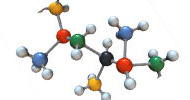
 Categories
Categories  Molecular Biology
Molecular Biology


Prostanoids, also known as eicosanoids, are a family of signaling molecules produced and secreted by various types of cells under both normal and...

Diacylglycerol (DAG), also known as diglyceride, consists of two fatty acid chains and a glycerol molecule. It primarily exists in two forms:...

Cholesteryl esters derived from cholesterol, are dietary lipids. They form when enzymes in the human body metabolize cholesterol with an ester bond between...

Carbon metabolism analysis in MtoZ Biolabs encompasses both one carbon metabolism and central carbon metabolism. The metabolism of certain amino acids can...

Amino acids are biologically important organic compounds, composed of amine (-NH2) and carboxylic acid (-COOH) functional groups, along with a side chain...

The ionome refers to the complete set of ions in an organism, including all metals, metalloids, and non-metals. High-throughput elemental analysis techniques...

During the tumor formation process, cancer cells release various cytokines and growth factors into the surroundings and reprogram many other types of cells...

Systemic lupus erythematosus (SLE) is a classic systemic autoimmune disorder characterized by impaired autoimmune tolerance and high concentration of...

The Gene Ontology (GO) is a database created by the Gene Ontology Consortium to provide a standardized vocabulary for gene and protein functions across...

The COG (Clusters of Orthologous Groups) database is an early and widely used resource for the homologous classification of gene products, based on extensive...

To validate the selection of differentially expressed proteins or characteristic differentially expressed proteins, cluster analysis can be performed to...

S-nitrosylation (SNO) is the covalent attachment of some nitroso (NO) groups to sulfhydryl residues (S) in proteins, forming S-nitrosothiols (SNOs). These...

Acylation is a post-translational modification involving the attachment of acyl groups, such as acyl-CoA, to proteins. This modification plays a pivotal role...

Protein phosphorylation is a reversible post-translational modification where amino acid residues in proteins are phosphorylated by kinases, which attach...

Peptides, structurally akin to proteins, are molecules composed of amino acid sequences. They play pivotal roles in regulating blood pressure, modulating...

Exogenous metabolites refer to external chemical substances, which can be either toxic or harmless. These exogenous metabolites include not only drugs but...

Metabolomics generally divides the credibility of metabolite identification into the following four dimensions: compounds reliably identified (Level 1),...

Structure-activity relationship (SAR) technology plays an increasingly important role in dealing with large and ever-expanding data sources. SAR techniques...

Obesity is a systemic disease, not only does it lead to changes in body shape, but it also brings along various diseases and complications, affecting an...

To maintain the immune system's homeostasis, multiple control systems are essential for managing infections, inhibiting tumor growth, preventing...